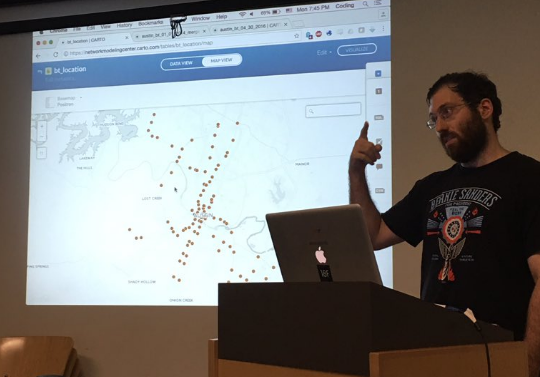
August Open Gov & Civic Tech Meetup Recap-Transportation & Sensors
UT Center for Transportation Research
For our August meeting we invited Jen Duthie (twitter) & Itamar Gal, from the UT Center for Transportation Research Network Modeling Center to speak about recent initiatives utilizing Austin Transportation Department sensor data.
Dr. @JenDuthie & Itamar Gal of @CTRUTAustin describe the #transportation Data Rodeo concept to @openaustin https://t.co/ZEdVgDsPFh
— Steven Polunsky (@StevenPolunsky) August 16, 2016
Connecting the Data
Duthie shared some of the difficulties in knowing who is collecting what transit data and what tools there are using to understand and share it. Duthie said “the gap [for collaboration] is so big and it doesn’t really need to be there.” She highlighted the need “to cut through the red tape” and make transportation data more accessible.
Because of this UTCTR is working on Data Rodeo. The idea for Data Rodeo came out the City of Austin’s bid for the Department of Transportation Smart Cities grant that was ultimately awarded to Pittsburg. It focuses on the following:
- Access to data & Tool
- Innovation & Collaboration
- Data centric research & Learning
- Enabling Smart Cities
"Getting access to data is slow but we are making huge strides" - Jen Duthie from @CTRUTAustin pic.twitter.com/2tsIEdkuzH
— Open Austin (@openaustin) August 16, 2016
Sensors
Itamar Gal finished out the the presentation. He stated that although collecting transportation data and collaboration are great, they’re not necessarily a city priority right now. Though this is true, the city currently has sensors that are collecting data at many intersections. He challenged the group to find uses for the data to help push interest and investment in the sensors and data.
Itamar shows a map where current static bluetooth sensors are located in the city. pic.twitter.com/eYM3a9e3jf
— Open Austin (@openaustin) August 16, 2016
Itamar showed the group a map that shows all the Bluetooth sensors that the city has. The current Bluetooth sensors are field sensor devices and sit statically at intersections or near them. The Bluetooth sensors look for devices with active Bluetooth (which could be pedestrians, cyclists, cars with Bluetooth-enabled stereo). When an active Bluetooth device is nearby, the sensor logs the time, the location of the sensor, and a hash of the device’s MAC address. Using the hashed MAC address, you could track a device as it travels between sensors to get an idea of the travel time.
The radar sensors have the potential to be more useful than the Bluetooth sensors because it could not only detect pedestrians, cyclists, and cars without active Bluetooth devices, but could also measure their speed.
After displaying the data, Itamar highlighted that it would be great to expand the network. Jen Pointed out the city is struggling between starting and maintaining the own network or paying for subscription of data from other entities.
Itamar concluded with am animated heatmap of the bluetooth sensor reading throughout the day with CardoDB. He believes the community could do interesting things with the data. Jen said that “we put out our reports and show our story but want to give other people the chance to let other stories emerge.”
To get involved, give feedback, or ask questions then you can email Jen Duthie, Ph.D., PE at jduthie@utexas.edu or Itamar Gal, Ph.D. at igal@utexas.edu.
Presentation Slides
Continue the Conversation
Join the Open Austin community on Slack: Get an invite
RSVP for our future events on Meetup: RSVP
Follow us on Twitter
& Like us on Facebook